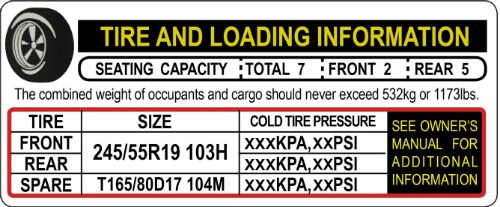-
Find your fit
Let’s find the right tire for you.
-
Browse tires by
- Vehicle Type
-
Product Line
- Tire Use
Tire Pressure Monitoring Systems
TPMS
TPMS low tire pressure indicator
The TPMS low tire pressure indicator is a yellow symbol that illuminates on the dashboard instrument panel in the shape of a tire cross-section with an exclamation point.
EXAMPLE OF A TPMS WARNING LIGHT
![]()
Common questions about TPMS include:
- Why is tire pressure important?
- What is TPMS?
- Does my vehicle have TPMS?
- What does the TPMS light on the dash mean?
- What am I supposed to do when the TPMS light is on?
- The TPMS light was on, but it went off on its own, do I need to do anything?
- How much will TPMS repairs cost?
Why is tire pressure important?
Air pressure enables a tire to support the load, so proper inflation is critical. Tires can lose one psi (pound per square inch) per month under normal conditions. Additionally, tires can lose one psi for every 10°F temperature drop. Underinflated tires and overloaded vehicles are the leading cause of tire failure. Furthermore, underinflated tires are subjected to heat and stresses that can lead to tire damage and/or unexpected rapid loss of pressure.
What is TPMS?
A tire-pressure monitoring system (TPMS) is an electronic system designed to monitor the air pressure inside of a tire and then report real-time tire pressure information to the driver. Even though a TPMS can deliver accurate alerts when properly maintained, it’s not a replacement for manual air pressure checks. Toyo Tires recommends checking tire pressure, including the spare, at least once a month and before every long road trip.
Does my vehicle have TPMS?
TPMS is required equipment on model year 2008 and newer passenger cars, light trucks and vans with a gross vehicle weight rating (GVWR) of 10,000 pounds or less. Some vehicles manufactured prior to 2008 are also equipped with TPMS so check your owner’s manual if you are unsure whether your vehicle has this feature.
Prior to working on your vehicle, your tire dealer should check if it is equipped with TPMS. If your vehicle is equipped with a direct system with wheel mounted sensors, your tire dealer may inform you that additional expense may be incurred if a sensor needs to be replaced and/or reprogrammed prior to beginning work on the vehicle. You should also be aware whether your vehicle is equipped with TPMS so you understand the repairs that may be required.
What does the TPMS light on the dash mean?
The yellow TPMS warning light alerts the driver that one or more tires is significantly underinflated and possibly creating an unsafe condition.
What am I supposed to do when the TPMS light is on?
Slow down and pull over as soon as it is safe to do so and check and adjust, if necessary, the air pressure in your tires. The warning light may turn off after the inflation pressures are adjusted. However you may need to drive the vehicle for a short period of time so the system can update itself before the light turns off. If your warning light is still on after adjusting the tire inflation pressure according to your vehicle’s tire placard, there may be a malfunction with the TPMS. Bring your vehicle to a professional to diagnose the system.
EXAMPLE OF A VEHICLE TIRE PLACARD

The TPMS light was on, but it went off on its own, do I need to do anything?
Yes. The light came on because the TPMS identified either a system malfunction or one or more tires with pressure below the threshold. Any time the light illuminates, you should check the air pressure of your tires with a gauge.
How much will TPMS repairs cost?
Maintaining your TPMS may come as an unexpected expense when taking your vehicle in for service or tire replacement. Just like any part on your vehicle, the TPMS sensor can corrode or wear out over time. Your tire dealer should diagnose any problems before working on your vehicle so you understand the service required and associated costs. Tire dealers cannot bypass the TPMS system. They must repair, replace or recalibrate failed sensors and ensure the TPMS system is operational to be in compliance with the law.






